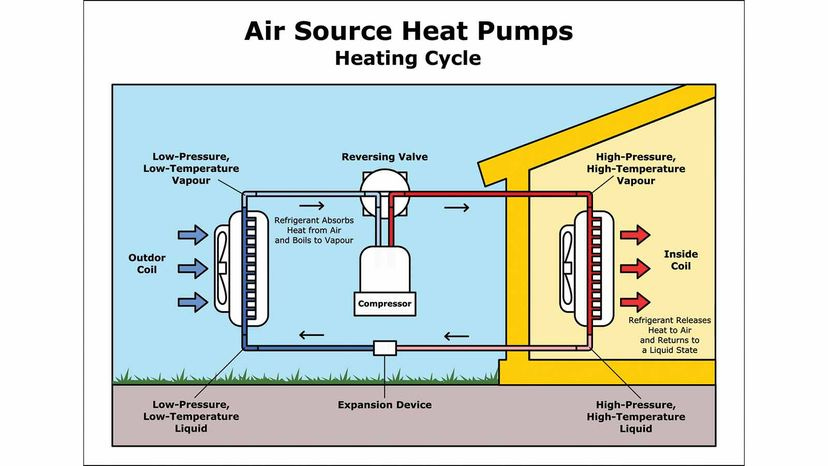
In the classic Saturday Night Live skit “Pumping up with Hans and Franz,” two Arnold Schwarzenegger- inspired meatheads (played by Dana Carvey and Kevin Nealon), make fun of “girly men” for not appearing as strong and manly as they (supposedly) are. The obvious joke being that “if you have to say it, you ain’t it.”
And so it may be the case with heat pump HVAC technologies. Reigning as the current Green Energy Diamond of the Season, media coverage praising the miracles of the (formerly humble) heat pump is prolific. But is this transformation truly swan-like, or are heat pumps doomed to be forever the ugly duckling? Dearest reader, have I got a story for you!
Back to Basics
First, a little background. Basic heat pumps have existed for as long as modern refrigeration. The foundational technology is a simple air conditioning unit using compressors to transfer heat from the inside of the building to the exterior, while the intake air is cooled by chemical refrigerants and recirculated back into the conditioned space. The novel aspect of heat pumps sold as both AC and heating units is that the process can be reversed with a valve, where warmer ambient air from the outside is pumped into the building and amplified by the pressure in the compressor to create a heating effect. And voila: the result is a combined HVAC unit that is, on its face, much more efficient than electric resistance heaters, and without the fuel source requirements of traditional natural gas and propane furnaces. The diagram below depicts the thermal flows of a typical air-source heat pump:

A Lot of Hot Air
Thanks to the laws of thermodynamics, heat pumps are in fact amazingly energy efficient. While electric resistance and gas-powered furnaces can never exceed 100% efficiency (that is, they convert 100% of consumed energy to useful work; i.e., heat), heat pumps can achieve 300-400% efficiency on a Joule of energy consumed-to-Joule of energy provided basis. This is because heat pumps do not “generate” heat in the manner of conventional heating technologies. Rather, they simply move air around using highly efficient compressors and evaporators.
But, as the saying goes, there’s no such thing as a free lunch. Heat pumps suffer from what I call the “Princess and the Pea Syndrome” — they work incredibly well as long as they are employed in warm and temperate climates. The graph below illustrates this point: the top ten U.S. states with the highest penetration of heat pumps are all in the South and Southwest. Texas and California are notably absent, mainly due to the expense of replacing legacy gas infrastructure that has historically limited homes and businesses to gas and propane-fueled furnaces in these states.

Cold as Ice
Installing heat pumps in places where temperatures rarely dip below freezing is, generally speaking, a fine way to reduce electricity consumption and CO2 emissions. The trouble lies in selling heat pumps as a one-size-fits-all “green” policy solution in cold climates where they make little economic sense. A piece recently published by IEEE Spectrum states the following:
The colder the temperature outside, the harder heat pumps must work to extract and move enough heat to maintain the home’s temperature. At about 4 °C (39.2 °F), most air-source heat pumps currently on the market start operating at less than their full capacity, and at some point (usually around -15 °C / 5 °F), they can no longer do the job at all. At that point, an auxiliary heat source kicks on, which is less efficient.
Considering that parts of the Northeast, Midwest, and Plains States endure temperatures well below 40 °F, sometimes for months on end, the lowered efficiency resulting from using a product that is not designed to function well in those conditions makes the proposition of installing heat pumps a dubious one. Less-than-efficient operation of heat pumps not only increases end user electricity bills, but also shortens the estimated useful lifetime of the product. Furthermore, the lack of radiant heating element in heat pumps means that the recirculated air retains more humidity and may make a poorly-heated space feel even colder. Some consumers also report high levels of constant ambient noise when running heat pumps on very cold days.
Newer models marketed as “cold climate heat pumps” are now making their way onto shelves. The main differentiating feature is a variable speed compressor powered by an inverter, that can automatically sense and adjust the levels of compression needed, thus improving the overall efficiency of the device. Other models suitable for cold climates are ground source (geothermal) heat pumps that pull heat from underground into the building with a heat-exchanger. While these technologies may prove promising, they are much more expensive to purchase and install than the more common single-speed compressor heat pump. A typical air-source heat pump runs around $2,000-$5,500, with an additional $1,300-$2,000 in installation costs. Because they are newer and less data is available about actual costs of installation, cold climate heat pumps are harder to assess, but contractors estimate that they can range anywhere from $10,500-$18,975 combining both unit and installation costs. Finally, geothermal heat pumps are prohibitively expensive for most, clocking in at $3,000-$6,000 for the device, and a whopping $10,000-$30,000 for installation.
Pump N’ Dump(?)
But, you may ask, what about incentives? Indeed, as a priority of the Biden-Harris Administration, incentives for heat pumps and other energy efficiency measures have been heavily advertised to encourage uptake in homes and commercial properties. Currently, the federal government offers a “tax credit of 30% of the costs of buying and installing a heat pump, [and] up to $2,000 including support for any electric system upgrades needed to make the home heat-pump-ready.” Beginning later this year, some states will roll out their versions of the High Efficiency Electric Home Rebate Act (HEEHRA), supported by the Inflation Reduction Act. HEEHRA will provide low- and moderate-income households with point-of-sale rebates on heat pumps up to $8,000 including purchase and installation costs, with an additional $4,000 if upgrades to the home electrical panel are needed.
These rebates may help to increase penetration in areas where the cheapest versions of air source heat pumps are widely available and climate appropriate. However, most warm weather states are already at or near saturation. Since it is primarily cold climate regions where penetration is low (for reasons discussed above) rebates would have to adequately cover the more expensive cold climate-ready heat pumps to be effective. Because of the wildly variable costs of installing these more sophisticated models, even a rebate of $8,000 may not be enough to encourage homeowners in cold regions to switch to heat pumps instead of choosing to stick with dependable and cheaper electric resistance ($2,000-$4,000 total) or gas furnaces ($3,000-$8,000 total).
The wildcard states of Texas and California, where climates are favorable for heat pumps and penetration is low, will likely be of particular interest for the HEEHRA program. With about 50 million residents, California and Texas combined represent about 15% of the total U.S. population, and therefore, a large potential target for further heat pump adoption. However, the additional expense for homeowners to reconfigure their properties and replace gas-fired furnaces with heat pumps may prove to be a difficult hurdle. Moreover, even in mean, green California, current state funded incentives for heat pumps are having less-than-stellar results, plagued with confusing processes for claiming rebates, and suffering from a lack of contractor know-how. Thus, the jury is still out as to whether the federal rebate program will have the desired effect of meeting the stated goal of installing 20 million residential heat pumps by 2030.
Pumping the Brakes
High electricity rates are yet another factor that will likely chill customer reception towards heat pumps. Nowhere is this problem more acute than in California, where the average residential retail rate is now $0.35/kWh, and often much higher during the peak hours of 4pm-9pm, when utilities charge more to disincentivize excessive use of appliances, lighting, and AC. By comparison, the equivalent cost of natural gas in California (converted from therms) is about $0.08/kWh. With electric bills all over the country similarly skyrocketing (to pay for costly solar and wind projects as well as grid hardening and expansion), it is little wonder that customers are reticent to give up gas furnaces, which are much cheaper to operate than heat pumps.
Whether reducing the stock of residential gas furnaces will similarly reduce CO2 emissions in the aggregate is also an open question. Depending on the local grid mix, electricity may be generated from coal as the primary energy source. When coal burned as generation fuel is added to end-use consumption, heat pumps may be more deleterious to the environment than simply using gas furnaces. This problem is of concern in Texas, Wyoming, West Virginia, and many midwestern states, where coal still plays a large role in producing electricity.
Finally, depending on all-electric HVAC systems creates vulnerability in the case of extended power outages. Particularly relevant to areas where winter storms can leave residents sitting in the cold and dark for more than 24 hours, relying on electricity to heat homes without sufficient backup generation can turn deadly. It is incumbent on would-be buyers and licensed contractors in these regions to perform due diligence and to ensure that homes equipped with heat pumps are also outfitted with generators or oil/ wood-burning stoves that can provide heat in the event of a power failure.
So is a heat pump right for you? The answer remains between you and your God (or local contracting guru, as the case may be). But you’d better believe, there’s someone out there with a fistful of rebates, ready to “pump…YOU UP.”
Electrically yours,
K.T.




The most informative piece that I’ve read on heat pumps! (I’ve read a bunch)
You were successful in maintaining your objectivity on a topic in which most authors are obviously “pitching” a pro or con opinion.
I love the fact you captured fuel cost in your article. I ran the numbers for my 96% gas furnace vs a 400% heat pump. Based on my gas cost vs my electric rate it's still cheaper to run the gas furnace. We all know that 400% only happens in the lab.
If you really want to embrace heat pumps, a duel fuel system is always an option. They run on heat pump during mild weather, then switch to gas furnace when the weather cools. The advantage is you can size the heat pump for cooling load.